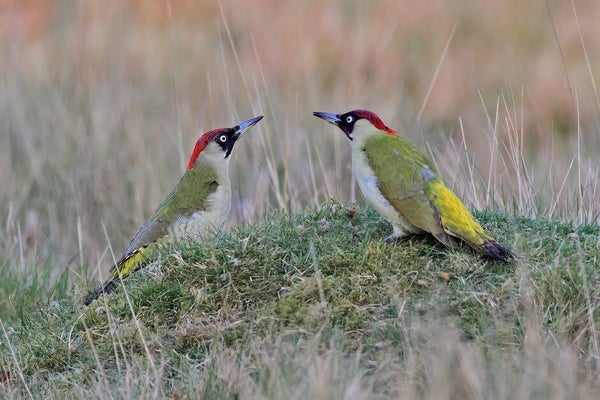
Quick facts
Common name - Green woodpecker, Great spotted woodpecker, Lesser spotted woodpecker
Scientific name - Picus viridis, Dendrocopos major, D. minor
Plants affected - Trees
Main signs - Tree cavities, ragged holes in tree bark
Most active - Spring
What are woodpeckers?
There are three species of woodpecker in the UK; the green woodpecker (Picus viridis), the great spotted woodpecker (Dendrocopos major) and the lesser spotted woodpecker (Dendrocopos minor).
Great spotted woodpeckers (the size of a blackbird or starling) are often heard before they are seen, distinguished by their distinctive ‘chip-chip’ call or loud drumming. These black and white birds are common in woodland and are frequent visitors to our garden bird feeders. Insects are their favoured food source. Great spotted woodpeckers use their powerful beak to hammer nest holes in trees and extract beetle larvae from under the of trees with their long, flexible tongue. Caterpillars, adult beetles and spiders are also taken.
The green woodpecker is the largest woodpecker (bigger in size than a blackbird) in Britain; with olive to dark green wings, a yellow rump and a red crown. These woodpeckers are usually spied on the ground in grassy habitats or garden lawns searching for ants; their favoured food source, using their strong beak to dig into ant colonies. They have a recognisable loud, laughing call known as a ‘yaffle’.
The lesser spotted woodpecker can be found in the tops of trees, searching for a range of invertebrates including, spiders and wood-boring insects on smaller branches. Similar in appearance to the great spotted woodpecker; it is differentiated mainly by size being much smaller (the size of a house sparrow). It is however, now a rare sight in the UK. This once-abundant species is now amongst the UK’s most rapidly declining birds and is on the UK Birds of Conservation Concern Red List.

What are the signs I have woodpeckers?
If you have dead trees and logs in the garden, you may be lucky enough to have woodpeckers. They do not usually damage healthy trees and play an important role in a healthy balanced ecosystem of a garden.
The interaction between woodpeckers and trees is complex. Understanding why woodpeckers drum/peck at trees is important and their behaviour falls into four categories:
- Feeding on invertebrates. Woodpeckers do not usually peck at healthy trees. It is likely that there are wood-boring insects already in the tree that have attracted their attention. As long as the beetle grubs or other insects remain then the woodpeckers will return
- sucking. Woodpeckers have also been observed creating rows of ‘peck marks’ in trees and it is believed that this behaviour enables them to access and feed on tree sap
- Nesting. When a woodpecker excavates a cavity for a nest it makes a small hole in the living sapwood and a large cavity in the heartwood. The hole in the sapwood is not big enough to cause any significant damage and the cavity in the dead heartwood doesn’t affect the health of the tree. The wood on the inside of a tree is called “heartwood”. This part of the tree is not alive; the dead cells support the tree and make up the bulk of the weight of the trunk but it does not help the tree to survive or carry out processes necessary for life
- Communicating. Drumming helps woodpeckers establish and defend their territory, attracting mates and deterring predators. Loud drumming is most effective when a dead hollow branch is used as this empty cavity makes more noise. This type of activity does not damage trees
Ecology
Woodpeckers are present throughout the year but are particularly active and visible in gardens during spring.
Keeping bird feeders topped up with peanuts, sunflower seeds and fat balls, and leaving dead wood which house wood-boring insects will encourage great spotted woodpeckers into your garden. Leaving areas of long grass for ants and insects will also create ideal habitat for the green woodpecker.
Woodpeckers breed in holes they peck in dead heartwood. Four to six eggs are laid inside between April and June (1-3 clutches per year). They hatch after around two weeks and chicks spend just over three weeks in the nest before fledging.

